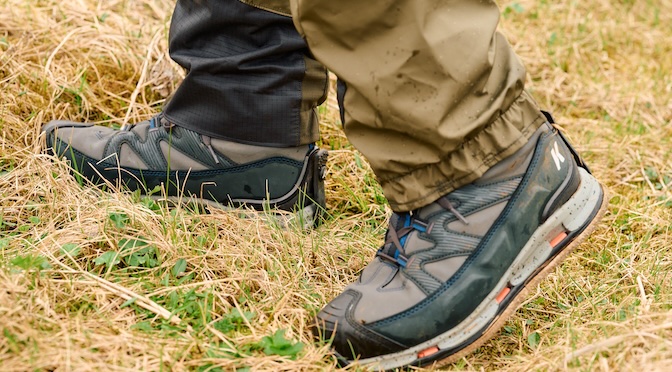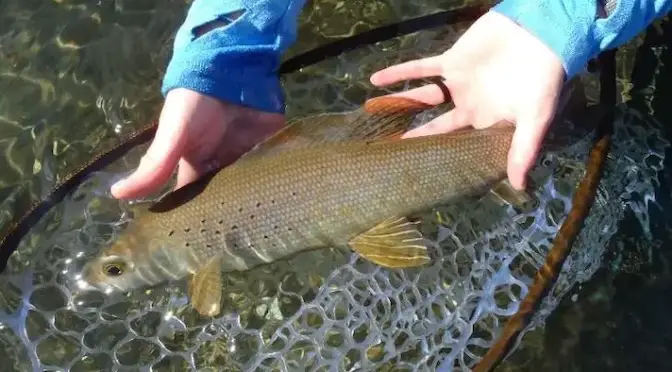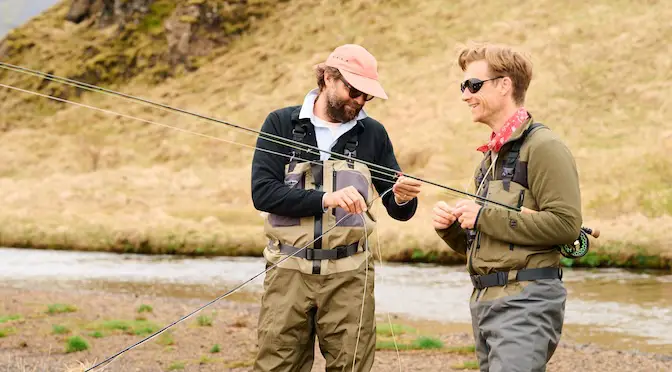Last updated on January 9th, 2024.
- Big Trout at Night – Vampire Hours - August 8, 2019
- Giant Browns of the Bay of Plenty - March 21, 2018
- A Workout for Wild Trout in Urewera - December 3, 2017
I heard them well before I saw them – big splashy thuds as they launched at the iron bars of their cage, desperately trying to break out of the cunning trap so as to continue their urgent way up the small stream.
As I came around the corner I saw one leap again, some three feet high, before getting knocked back into the holding pen. They were browns, all of them and amongst them must have been seven or eight twelve to fifteen pound fish. These monsters of the lake looked awkward in this tiny stream and were angry at being prevented from moving through. I stood above them in awe, and couldn’t help feeling thrilled that this was the caliber of fish I was to look forward to this summer in New Zealand’s Bay of Plenty region, fishing the spring creeks of the Mamaku Plateau.
In the last few years the brown trout of Lake Rotorua have made quite a name for themselves, and it is the opinion of many that the lake is possibly the biggest producer of double figure trout on the planet. One can see why, when there are some hundreds of these monsters passing through the stream mouths during the weeks of December and January, and then again in March and April. This effectively creates a trophy fishery that spans from December all the way through to the closing of the water on June 30th.
Rotorua is a very shallow lake, and as a result it warms considerably under the extremely high sunshine hours of the Bay of Plenty during summer (Dec – April). Lake Rotorua boasts the highest catch rate of rainbows in New Zealand, and these can be seen in their hundreds at this time – crowded into the small stream mouths trying to keep cool. The fishing opportunities are fantastic, and the visual nature of fishing to huge amounts of these rainbows lying right at your feet is quite something to behold. Often, one will sight an absolutely massive brown trout lying amongst the 3-6 pound bows at these stream mouths. It is these browns, which exceed 15 pounds in weight, which are the target of my summer/autumn guided fly fishing season.
Unlike the rainbows of Rotorua, these browns begin their spawning runs in early December and are followed by a second larger run later in autumn around March. I sometimes wonder whether this first summer run of mega-browns haven’t clicked on to the abundant food supply of eggs and hatching rainbows freshly left in the streams gravels by the winter rainbow runs? Probably not – they can’t be that wise can they? It is more likely that they head up the streams for the peace and quiet seldom found at the stream mouths, and, of course, the cold spring water. Whatever, it is safe to say that they are up there to spawn and as a result they are certainly difficult to catch. The sheer size of them makes them difficult to catch in such small, snag-infested water armed with only a flimsy fly rod, let alone the fact that they very seldom feed during the hours of daylight, opting to lie in hiding, biding their time for the big moment of procreation. However they aren’t infallible, and do get caught with regularity over the remainder of the summer and autumn months….there are a few tricks to it though.
Where to find the huge browns
Perhaps the easiest place to target these massive trophy trout is at the very stream mouths themselves. The brown trout will lurk around the mouth area for a number of days before moving on up – perhaps stimulated by a small fresh, drop in atmospheric pressure or rise in lake temperature. It is more productive to fish these open, snag free stream mouths at night, where a one hundred metre run can be contained without too much trouble. The thing is that most people who fish these stream mouths don’t actively target the browns, and as a result spend their evening catching rainbows. To target the browns take the following advice and be prepared to spend a fishless evening or two in the knowledge that when you do hook up it’ll be the fish of a lifetime.
The first thing you have to do is tackle up. Use a strong nine weight rod and floating line. A standard Tongariro nymphing outfit fits the bill perfectly. I use a fine diameter twenty pound leader for one reason only….I have seen and hooked browns in excess of twenty pounds. No point going to all that trouble to get a hook-up only to be broken in two seconds flat, and at night I believe that the fish can see your leader as well as you can.
Now, browns are extremely lazy creatures, opting for slower water whenever possible. Don’t stand in the main rip as you would to catch rainbows. The browns will be cruising well off to the sides in the still water. Stand twenty to thirty metres off to the side of the flowing water in only knee deep still water. Whack a large size four black Woolly Bugger on the end and cast as quietly as possible all around you. You need a strong steel hook as anything less stands a good chance of being straightened. Use an exceptionally slow retrieve, just twitching your fly every twenty seconds along the bottom. This emits little puffs of silt and gives you a longer actual “fishing” time. The less casting you do the better as these fish are very wary and will spook easily.
As a result of your slow retrieve the takes will be extremely subtle so it pays to strike every little knock and bump you feel. Try not to strike by whipping your rod and line into the air and thus shattering the still water around you – instead just give a short sharp pull directly on the line in your retrieve hand. This sets the hook with a direct pull, and doesn’t spook the water as it would when you lash your line and rod sky high as in a normal strike. If it is a big brown then be prepared for a huge first run, and the beauty of fishing on the lake like this is that you can generally let them run without fear of snagging. Up the creek it’s a different story as they seldom have to run more than five feet to get to fallen branches or overhanging blackberry to bury you in.
The trick to getting a hook into the browns up the stream itself is to get a presentation without actually being seen by the fish. But first one has to spot the fish. Pay special attention to the overhanging foliage and undercut banks. You will often see the shape of a large pectoral fin the size of your hand sticking out. Make an effort to get on the river on a clear, blue-sky day after a settled period with no rain. This increases your spotting ability ten-fold. Stick with the heavy outfit mentioned prior – I’ll still use a fine diameter 20lb leader and a large size eight nymph. The biggest problem after hooking a big brown up the stream is stopping it charging into the nearest snags. Mostly this is impossible, as just the flex of your rod is enough to see them find a good hole to burrow into, however with 20lb tippet you can really give them heaps right from the start. I have found that if you really whack them on the strike, then there’s a good chance they will barrel on the surface at first, disorienting them and giving you just half a chance of banking it. I’m often asked how you “stop” these big fish in small water? The answer is – you don’t. You’ve just got to keep up.
 A giant brown in a small creek – Miles Rushmer
A giant brown in a small creek – Miles Rushmer
Using the dark to your advantage
Most of these huge browns that you come across during the daytime are in hide mode. Neither moving nor feeding and can be frustrating to try and hook. Once again though, they will take readily at night providing they are unsuspicious. Stake out a pool where you know the fish are, then return quietly at 10pm and ever so stealthily flick a dark coloured booby fly through the bottom of the pool. Use a fast sinking line and only one and a half foot of heavy leader. Let it sit on the bottom for five minutes before you begin that excruciatingly slow twitch back. The “strip strike” is the go up here too, as a full strike usually sees your fly line end up in the trees around you.
Once in a while these rogue fish seem to loose their minds and feed actively all day. I have also seen them tucked in behind a pair of rainbows later in autumn scoffing eggs. In situations like this they are absolute sitters and will readily chomp a glo-bug, providing they never see you. On other days I have had every brown I’ve seen attack nymphs with reckless abandon. Why? Must be due to some combination of tide, pressure, moon and god knows what else. What I have noticed is that our big tally days, with as many as eight double figure fish banked, have been during and directly after rain – when the stream is high and coloured. I also know that directly after spawning, food takes a much higher priority than before, however it is the pre-spawn fish that are in the best condition, and going to the extra lengths of crawling on to the stream at night is often well worth the effort.
Another tactic worth trying is simply dangling your fly right on the fishes nose and bugging it into striking. I have watched this happen on a number of occasions, when the fish quite simply gets to the stage where it’s had enough and either swims off or bites the object of its distraction. One must strike very quickly when this happens as it is simply an aggressive bite as opposed to it taking food, and the nymph gets spat out very, very quickly. Use as big a fly as you have got to provoke this response.
From hooking to landing a double figure trout
With a fish of this size it is hugely beneficial to have a mate on net duty. Most of the 30 odd double figure fish we banked this season involved two people. One on the rod – the other on the net, with the net man often enjoying their own battle some metres downstream. To bank one solo is quite an achievement. The net man is also responsible for clearing your line away from all the snags your fish has tried to run you through, so you can then follow unimpeded. It’s quite incredible how effective this is, and large branches, flax and logs can simply be lifted out of play – negating the dirty fighting tactics of these huge trout. They can also “block” your fish from heading downstream into foul country by simply standing in the water and scaring them back up to you.
Sometimes these fish have become so territorial that they are reluctant to leave their small area called home, and a relatively easy fight sees your net man in the water trying to scoop your monster into such a small net. Oh – don’t bring a small net! Your net man also needs to “trace” your fish – marlin styles, in order to get it into the net head first. Always try to net them head first – they don’t fit in sideways, and a touch on the tail just speeds them up! One soon learns the feeling for knowing when to let the leader slip and when to hold them for a shot with the net. Your net man often has better control of a fifteen pound brownie than you do on the rod.
As with most fishing, all it really comes down to is employing the right tactics, targeting your fish, and putting in the time. Be prepared for when you do hook a monster, and also be prepared to get smoked on the spot, time after time, until eventually one makes all the right mistakes in your favour and you get to bank your first huge double figure brown from the tiny spring creeks of the Mamaku Plateau.
Tackle:
Minimum 8 weight outfit/ floating line
15-20lb fine diameter tippet (Pioneer Flexline)
Flies: Large #6 champagne, red dot globugs (clear water)
Apricot, white dot globugs (coloured water)
#8 Super bushy Hare and Copper
#6 Booby in black (night time) White (day time)
An extra large net!
Contact Miles Rushmer here.






